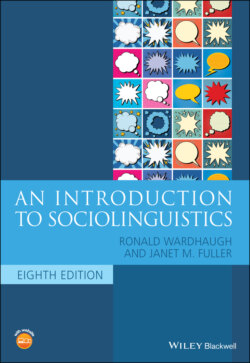Читать книгу An Introduction to Sociolinguistics - Ronald Wardhaugh, Janet M. Fuller - Страница 14
1 Introduction KEY TOPICS
ОглавлениеWhat makes a system of communication a language
What it means to ‘know’ a language
How language varies across language users and within the language use of one person
The social construction of identities
The relationship between language and culture
How to define and delineate the study of sociolinguistics
Sociolinguistics is the study of our everyday lives – how we use language in, for example, our conversations or social media interactions, and how this language use is influenced by the presence of societal norms, policies, and laws which address language. Since you are reading this book, you may already have some idea what the study of sociolinguistics entails; you may already have an interest in, and knowledge about, regional dialects, multilingualism, language policy, or non‐sexist language. And we will cover all of these topics, along with many others – for example, what social class and ethnicity might have to do with language use, why we do not always ‘say what we mean,’ and the role of language in education.
But we would like to encourage readers to approach the study of sociolinguistics not only as an empirical approach to studying language and society, but as a way of viewing the world around you. In sociolinguistics, we seek to analyze data so that we can make generalizations about language in society, but also to question both our findings and the very process of doing research. Take, for instance, the topic of nicknames. There is a stereotype that men use nicknames and women do not, exemplified in the following joke:
If Diana, Natalie, Naomi, and Maria meet for lunch, they will call each other Diana, Natalie, Naomi, and Maria. But if Matt, Peter, Kirk, and Scott go out for a brewsky, they will call each other Dutch, Dude, Doofus, and Pencil.
We could investigate this sociolinguistic phenomenon by surveying people about their nicknames and also observing or recording interactions in which they are addressed by close friends and family members. We might find, indeed, that the men in our study are often called nicknames, while the women rarely are. But we would like to go deeper than this generalization; why do we ask this question in the first place? Why do we assume that the categories of ‘men’ and ‘women’ are socially relevant? What is it about nicknames that makes using them, or not using them, significant social behavior? And even if most men are called by a nickname and most women are not, how do we explain the existence of individual men who do not have nicknames, and the individual women who do?
Thus, while in sociolinguistics we analyze linguistic interactions with the goal of making generalizations, we also question these generalizations and examine how they, in turn, influence how we use language. In short, the goal of sociolinguistics is not to make simple observations (e.g., men call each other nicknames, women do not) but to study the complex ways in which societal norms are intertwined with our language use (e.g., what it means to be a male or female member of a particular society may influence the terms we use to address each other).
We will come back to these points repeatedly: language, society, and sociolinguistic research findings must all be viewed in their social contexts, interpreted, and redefined. To begin, however, we will offer a starting point for discussing language in society. By society, we mean a group of people who are drawn together for a certain purpose or purposes; this is a rather vague and broad term, and throughout this book we will be engaged in discussing how to draw meaningful boundaries around a group of language users for the purposes of studying their language (see in particular chapter 3). We use the term language to mean a system of linguistic communication; this includes spoken, written, and signed modes of communication. A note here about terminology: although the majority of the research we will refer to is on spoken language, there is an increasing number of studies looking at written discourse (especially from social media) and we also do not wish to exclude those who communicate through signed languages. Thus, we will use the term ‘language user’ instead of the more commonly used term ‘speaker’ as a general term.
The main idea we would like to convey here is that language is inherently social. A society must have a language or languages in which to carry out its purposes, and we label groups of people with reference to how they communicate – e.g., Spanish speakers, bilinguals, American Sign Language users. This connection is inevitable and complex; our purpose here is to study the relationship between language and society in more specific ways which help us more clearly define and understand both the social groups and the ways they speak.
In this introductory chapter, we will present some of the basic concepts in the field of sociolinguistics: what defines a language, what it means to ‘know’ a language, the nature of differences across and within languages, the importance of social group membership in language use, and different ideas about the relationship between the worldviews of these groups and the languages they use. Further, we will provide a brief discussion of how sociolinguistics draws on ideas from a variety of disciplines for key concepts and approaches to the study of language.
